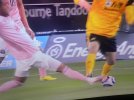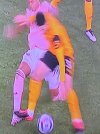
You are using an out of date browser. It may not display this or other websites correctly.
You should upgrade or use an alternative browser.
You should upgrade or use an alternative browser.
Wolves v SUFC
- Thread starter Bet Middler
- Start date
Biased opinion.
I honestly don’t think it is a stamp (think he has tried to shield the ball, but has made contact. Don’t think the player could do anything about that, however not sure how it was a WWFC FK.
However I’m quite amazed that it is a yellow card to pink as the momentum was carrying him forward, if anything.
be interested to hear other opinions on this one.
I honestly don’t think it is a stamp (think he has tried to shield the ball, but has made contact. Don’t think the player could do anything about that, however not sure how it was a WWFC FK.
However I’m quite amazed that it is a yellow card to pink as the momentum was carrying him forward, if anything.
be interested to hear other opinions on this one.
Last edited:
Bet Middler
New Member
Small margins, could and should have been Red,
Can't over turn a yellow/foul unless you are giving a red..its not a red so VAR can't advise to change the decision.View attachment 4912
Yellow to Brewster (in Pink)!!!! After VAR Check too!! Really!!
Bet Middler
New Member
It’s amazing how they’ve stitched it up so as to try and not make the ref see he’s made an error. Its clearly and obviously not a yellow card to pink regardless of whether you think it’s red the other way,!
Side note: I would like to see IFAB prohibit players from sliding to challenge for the ball immediately after they have miscontrolled it because, as seen in this example, it can be quite dangerous. Often it leads to two opponents sliding for the ball in opposite directions.
I myself have previously been injured after sliding for the ball after an opponent, who was in control of the ball, took a heavy touch. Unexpectedly, he also slid for the ball. Needless to say, we annihilated each other.
I myself have previously been injured after sliding for the ball after an opponent, who was in control of the ball, took a heavy touch. Unexpectedly, he also slid for the ball. Needless to say, we annihilated each other.
one
RefChat Addict
A still pic doesn't show much. That doesn't even show if there was contact. What minute of the game? The video is geo blocked.View attachment 4912
Yellow to Brewster (in Pink)!!!! After VAR Check too!! Really!!
Side note: I would like to see IFAB prohibit players from sliding to challenge for the ball immediately after they have miscontrolled it because, as seen in this example, it can be quite dangerous. Often it leads to two opponents sliding for the ball in opposite directions.
I myself have previously been injured after sliding for the ball after an opponent, who was in control of the ball, took a heavy touch. Unexpectedly, he also slid for the ball. Needless to say, we annihilated each other.
How do you define control?
May have been a Red Card, but the only potential for C&O error is based upon replays and photographs. No chance that it's a C&O error in terms of the Referees view or judgement of things. Red card may have been correct (and I'm not saying that it was), but only when re-refereeing the game
For me it’s difficult as because the player has slid in, it has meant that the orange player has gone to control/shield the ball, which has lead to that.
I have seen them given, but I do feel that it is not yet equivalent of a “racing incident” in F1 as the player cannot mind read that pink player is going to slide in.
Either way, thought we were lucky to get the three points!
I have seen them given, but I do feel that it is not yet equivalent of a “racing incident” in F1 as the player cannot mind read that pink player is going to slide in.
Either way, thought we were lucky to get the three points!
How on earth is it not a clear and obvious error though? The referee booked the Sheffield Utd player, give a free kick to Wolves yet he was the one who had studs planted into his leg.
Its a bad error by the referee and I have no idea what he saw to give a free kick to Wolves and book the Sheffield Utd player.
Its a bad error by the referee and I have no idea what he saw to give a free kick to Wolves and book the Sheffield Utd player.
Bet Middler
New Member
A still pic doesn't show much. That doesn't even show if there was contact. What minute of the game? The video is geo blocked.
Attachments
socal lurker
RefChat Addict
How on earth is it not a clear and obvious error though? The referee booked the Sheffield Utd player, give a free kick to Wolves yet he was the one who had studs planted into his leg.
Its a bad error by the referee and I have no idea what he saw to give a free kick to Wolves and book the Sheffield Utd player.
All clear errors are not reviewable. Cautions are not. Send offs (or lack of send offs) are. Son unless the VAR believes it was clear error to not send off a player, this play is simply not reviewable, regardless of how clear of an error the foul or caution might be. This was the balance struck between flow and accuracy.
Bet Middler
New Member
So if VAR isn’t putting right the wrongs then what’s it’s actual point. It seems to be picking and choosing when to be ultra picky and then making it up the protocols as they go along!
one
RefChat Addict
A lot of us dislike VAR but one thing we agree on is that if there, it should only intervenes on KMI's (key match incidents). And as it stands, they are goals, penalties and red card. If they where to intervene on every debatable decision then every game will take over 3 hours with less than an hour play time. The game would be ruined beyond repair.So if VAR isn’t putting right the wrongs then what’s it’s actual point. It seems to be picking and choosing when to be ultra picky and then making it up the protocols as they go along!
The second picture you posted is by no means a clear red. Studs pointing down. Knees is bent, contact is low and force is downward.... there are some elements there that 'could' make it red. But from the two pictures I have seen, a yellow is consistent with others yellows in EPL. What minute of the game?
WalterPinkman
Active Member
It would be very hard to define control. In addition to this, it would take a big competitive edge out of the game. I appreciate the potential risks with these type of challenges but we can’t prohibit players from challenging for the ball in certain situations.Side note: I would like to see IFAB prohibit players from sliding to challenge for the ball immediately after they have miscontrolled it because, as seen in this example, it can be quite dangerous. Often it leads to two opponents sliding for the ball in opposite directions.
I myself have previously been injured after sliding for the ball after an opponent, who was in control of the ball, took a heavy touch. Unexpectedly, he also slid for the ball. Needless to say, we annihilated each other.
Peter Grove
RefChat Addict
VAR was always supposed to be ultra picky and only intervene on the four kinds of predefined (and relatively rare) match-changing events. It is not supposed to right all wrongs.So if VAR isn’t putting right the wrongs then what’s it’s actual point. It seems to be picking and choosing when to be ultra picky and then making it up the protocols as they go along!
As stated in the protocol:
The aim of the experiment is NOT to achieve 100% accuracy for all decisions as there is no desire to destroy the essential flow and emotions of football which result from the game’s almost non-stop action and the general absence of lengthy stoppages. The philosophy is:
‘minimum interference– maximum benefit’
It's absolutely according to the protocol not to intervene if the VAR does not see a clear & obvious error involving one of the four categories defined therein.



